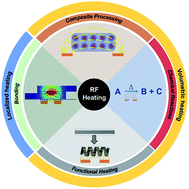Radio frequency heating and material processing using carbon susceptors†
Abstract
Carbon nanomaterials have been shown to rapidly evolve heat in response to electromagnetic fields. Initial studies focused on the use of microwaves, but more recently, it was discovered that carbon nanomaterial systems heat in response to electric fields in the radio frequency range (RF, 1–200 MHz). This is an exciting development because this range of radio frequencies is safe and versatile compared to microwaves. Additional RF susceptor materials include other carbonaceous materials such as carbon black, graphite, graphene oxide, laser-induced graphene, and carbon fibers. Such conductive fillers can be dispersed in matrices such as polymer or ceramics; these composites heat rapidly when stimulated by electromagnetic waves. These findings are valuable for materials processing, where volumetric and/or targeted heating are needed, such as curing composites, bonding multi-material surfaces, additive manufacturing, chemical reactions, actuation, and medical ablation. By changing the loading of these conductive RF susceptors in the embedding medium, material properties can be customized to achieve different heating rates, with possible other benefits in thermo-mechanical properties. Compared to traditional heating and processing methods, RF heating provides faster heating rates with lower infrastructure requirements and better energy efficiency; non-contact RF applicators or capacitors can be used for out-of-oven processing, allowing for distributed manufacturing.

- This article is part of the themed collection: Recent Review Articles


 Please wait while we load your content...
Please wait while we load your content...